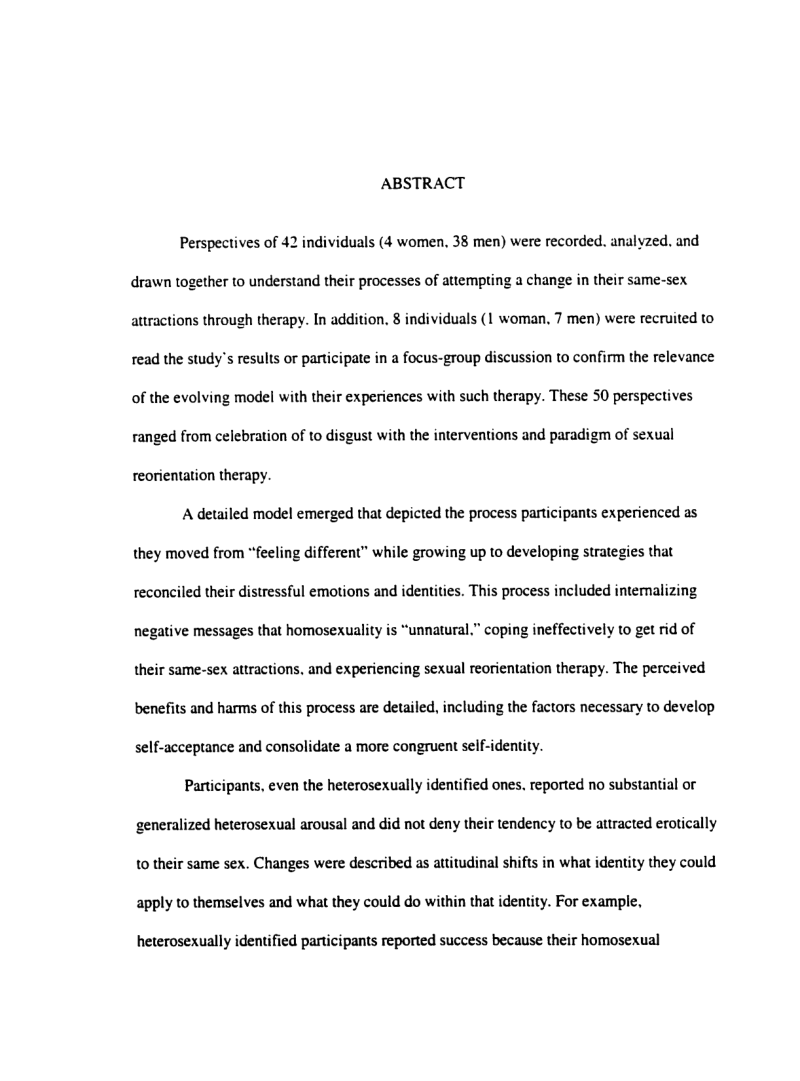University of Utah dissertation on 42 gay Latter-day Saints that have unsuccessfully participated in reorientation therapy.
- Type
- Academic / Technical Report
- Source
- Arvel Lee Beckstead LDSResigned
- Hearsay
- Direct
- Reference
Arvel Lee Beckstead, "The Process Toward Self-Acceptance and Self-Identity of Individuals Who Underwent Sexual Reorientation Therapy," Department of Educational Psychology, University of Utah, August 2001
- Scribe/Publisher
- University of Utah
- People
- Arvel Lee Beckstead
- Audience
- N/A
- Transcription
ABSTRACT
Perspectives of 42 individuals (4 women, 38 men) were recorded, analyzed, and drawn together to understand their processes of attempting a change in their same-sex attractions through therapy. In addition, 8 individuals (1 woman, 7 men) were recruited to read the study's results or participate in a focus-group discussion to confirm the relevance of the evolving model with their experiences with such therapy. These 50 perspectives ranged from celebration of to disgust with the interventions and paradigm of sexual reorientation therapy.
A detailed model emerged that depicted the process participants experienced as they moved from “feeling different” while growing up to developing strategies that reconciled their distressful emotions and identities. This process included internalizing negative messages that homosexuality is “unnatural,” coping ineffectively to get rid of their same-sex attractions, and experiencing sexual reorientation therapy. The perceived benefits and harms of this process are detailed, including the factors necessary to develop self-acceptance and consolidate a more congruent self-identity.
Participants, even the heterosexually identified ones. reported no substantial or generalized heterosexual arousal and did not deny their tendency to be attracted erotically to their same sex. Changes were described as attitudinal shifts in what identity they could apply to themselves and what they could do within that identity. For example, heterosexually identified participants reported success because their homosexual behaviors decreased, they felt an increased belonging to their gender. and they felt resolved in considering that all heterosexuals experience same-sex (emotional) needs. Participants who identified as gay after therapy reported that they expanded their perceptions of what it meant for them to “be gay” and spiritual and now viewed homosexual relationships as capable of being emotionally and sexually fulfilling.
Results suggest that although elements of such therapy may be beneficial (e.g. universality and reframing), its underpinnings (e.g.. misrepresentation and internalization of treatment failure) have the potential for great harm. However, as many participants indicated, all same-sex attracted clients may not benefit initially from gay-affirmative therapy. Therefore, this study provides a broader-based treatment plan, designed to produce the most benefit, the least harm, and congruent solutions for same-sex attracted clients who present in conflict.
. . .
- Citations in Mormonr Qnas
The B. H. Roberts Foundation is not owned by, operated by, or affiliated with the Church of Jesus Christ of Latter-day Saints.

